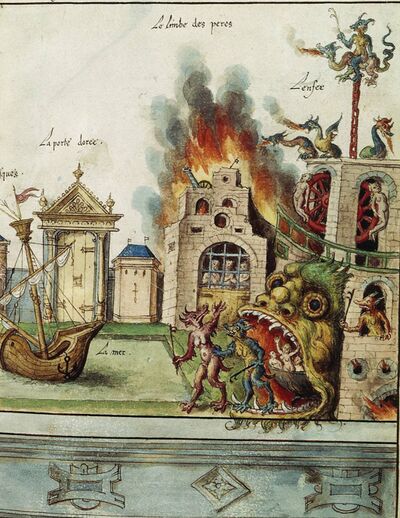Sound effects in religious plays[edit]
The religious plays of the Middle Ages made extensive use of sound effects, especially to create heaven and hell. Drums, cannons and pyrotechnics, as well as musical instruments, created spectacular effects to support the storytelling.
Across Europe, the religious plays of the Middle Ages were performed in churches but also outdoors, with a series of scaffolds around an open stage, each representing a different location required in the play (F.02). Many plays involved spectacular effects, costing a great deal of money: elaborate scenery, lighting effects, flying people and objects, explosions, earthquakes and miracles. The depiction of heaven and hell was crucial, so the effects of thunder for when God spoke or when angels appeared, and the diabolical sounds of hell, were important. Music, both instrumental and singing, was also extensively used.
Much of what we know about the sounds of theatre in the Middle Ages comes from descriptions of performances at the time, and the stage directions in scripts (G.02), as well as the detailed records of expenditure that were kept. These often indicate who was employed to do what, or what materials and devices were purchased or needed repair. Sometimes though these records are tantalisingly minimal. One of the oldest stage directions from the Middle Ages regarding sound is from a 13th century play called Adam, which for the depiction of hell required ‘an infernal din’. But how was that sound to be created, and what did it consist of?
Other sources give a little more detail. In 14th century France, thunder was required, to be produced by ‘stones rolled around in a tub’. The same method was described for a play called Doomsday, in York, England, when an earthquake was needed. With the arrival in Europe of gunpowder in the 13th century, explosions were added to the range of possible effects. In the early 15th century in Florence, a performance inside a church used ‘a volley of shots imitating Heaven’s thunder’ – one can imagine the effect of this inside the church’s resonant acoustics. Around the same period, for the Prades Assumption in Catalonia, explosions marked the return of an angel to Paradise, while the instructions for the same performance state ‘Lucifer and the other devils are to take an anvil and hammers to make a loud noise when the time comes’.
In the 16th century, contracts issued to those making the effects are revealing, setting out what is to be provided:
The cannons and flaming fireworks necessary for the devil-scene. They shall make a great blaze of fire and noise every time the devils take some dead to Hell, every day. They shall fire cannons and bombards when Gog and Magog greet Antichrist. They shall supply the large cannon and falconets [small cannons] with necessary petards [small bombs] to make earthquakes.
The number of people involved also gives a sense of the scale of the performances, and of the effects created: 2 x Thunderers, 4 x Musketeers, 4 x Hornblowers, and an unspecified number of smoke makers.
Records also indicate the equipment used: ITEM: For a new thunder barrel and for renovating the barrel of the old thunder barrel ITEM: For 12lbs of powder for the guns and the thunder
The 1501 Passion Play in Mons had people operating a thunder machine, involving ‘two large flat bronze basins’, which seem to have been mounted on a frame, face-to-face with rocks inside, in such a way that the whole construction could be rotated, as if on a spit. The rocks inside would have rolled around, producing the sound of thunder. This effect was supplemented by two wooden barrels covered with vellum skins, and a cauldron with a skin of parchment, to make drums that would create different types of sound. The same play also made use of a ‘thunder sheet’ (Q142), a large sheet of metal hung up and shaken to create the sound of thunder. This is the oldest record of the use of a thunder sheet, which continued in use in theatres until the middle of the 20th century, when recorded sound largely took over from live acoustic effects. The records of the play in Mons state:
To Pierart Viscave, tinker, for the installation of two big sheets of bronze for the aforesaid mystery, place in Hell to make thunder, has been paid: 32 shillings.
Many performances took place outdoors, with singers, musicians and effects people placed around the outside of the performance space so they could be heard. In some cases, musicians were placed below the stage, and sounds of thunder would come from overhead if the source could be placed in an attic of a house. But theatre in the Middle Ages did not operate within a convention of illusion or naturalism, as found later in theatre’s history. As with all aspects of the performance, effects were there to represent the thing they referred to, with no need necessarily to hide or disguise how the effect was produced.
Sound in the religious plays of the Middle Ages played an important role, and was produced by a variety of means, making use of the skills and available resources of the craftsmen and tradespeople in the community. These people were not full-time theatre-makers, but knowledge of the required techniques was passed on through the play scripts themselves, resulting in spectacular and impressive effects.

